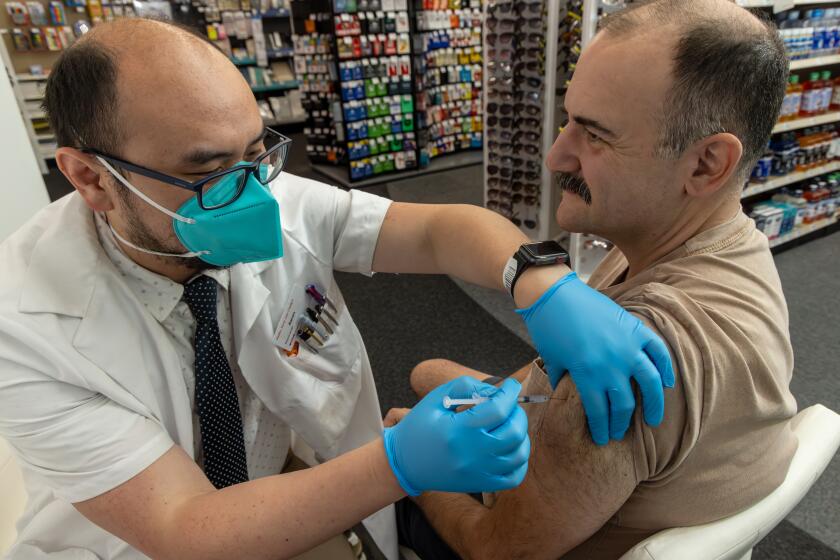Comprehensive Medical Exams--With Side Effects :...
- Share via
There is growing and justified criticism of American medicine based on evaluation of the risks as well as the benefits of medical care. Risks there are. It is to be hoped that one result of this trend will be to provide the public, as well as individual patients, with a more realistic picture of both the promise and the pitfalls of medical care, thereby improving patient welfare. Unfortunately, neither of the two books reviewed here helps much toward achieving this laudable goal.
“Medicine on Trial” is unabashed doctor-bashing, with little attempt at balance, perspective or, at times, accuracy. The tone is set by its subtitle. To be sure, medicine has more than its share of ineptitude, malfeasance, neglect, and arrogance, but medicine often is lifesaving, quality-of-life sparing, caring and even compassionate. The problem is how to reap the benefits of the latter characteristics and avoid the risks posed by the former. This book does not help.
The book is filled with shoddy, perhaps deliberate, distortions of the medical literature. For example, quoting a medical article, the authors label 59% of the physicians and 78% of medical students as users of psychotropic drugs. The implication is that during medical care, the odds are that you will be cared for by a “coke head” doctor. The actual article indicates that a serious problem with drugs affects fewer than 1% of doctors. Fewer than 1% is still too high, and the problem of the drug-abusing physician is a serious one. However, the authors have the responsibility of interpreting the data accurately. This they failed to do. As a result, the authors vastly overestimate the probability that you will be cared for by a drug-abusing physician.
Another example is that the authors flagellate doctors for the problem of misdiagnosis. Misdiagnosis is indeed a serious problem. But the three examples cited (blood clots in the lung, pneumonia and lung abscesses) are among the more difficult diagnostic problems encountered by doctors. These difficulties stem from the nature of the diseases and not usually from physician malfeasance.
There is a glaring omission in the book. This omission stems from cursory knowledge and cursory understanding of the medical system. Many of the problems faced by patients stem from a general phenomenon, iatroepidemics; that is, systematic errors in medicine which, once introduced and widely used on patients, result in widespread harm or death. Essentially, no description of this problem and its negative effect on patient welfare is provided.
Paradoxically, the authors display a basic faith in the current medical system. To whom should one turn to detect medical malfeasance? We are told to turn to other physicians. Given the black picture of physicians that the authors paint, how can they then urge trust? The authors rely on doctors for evidence but turn to boards of non-physicians for judgment and perhaps punishment.
The most annoying aspect of this book is that it requires me to sound like an apologist for the medical system. I am not. I suppose imbalance begets imbalance.
If you have tired of your copy of The National Enquirer and decide to read this book, it will be most useful in such cases as when an elective hysterectomy is suggested by your physician, or when your child faces a routine X-ray or tonsillectomy.
Disregard this book if you have had a heart attack (which can now be treated with a new lifesaving drug, TPA) or if you have an operable brain tumor or if you require blood transfusions, suffer from a bacterial pneumonia or have a child with meningitis.
Diana Dutton’s “Worse Than the Disease” goes to the opposite extreme. It resembles nothing more or less than an expanded thesis written to fulfill the requirements for a Ph.D. in sociology or history. Long on facts and short on insight, it’s pedantic and plodding. Its basic format consists of an extensive description of four medical events: the DES disaster, the premature use of the artificial heart, the swine-flu immunization program, and genetic engineering. None of the discussions are particularly insightful and the real connections between these events are not clearly spelled out.
Dutton, like the authors of “Medicine on Trial,” appears not to have heard of iatroepidemics, and it turns out that she is a cryptomedicophile, a hidden admirer of the medical system, warts and all.
Her suggestions for change are delightfully naive. For example, she writes, “physicians are generaly optimistic about what their field can do.” Ergo, perhaps if we had more pessimistic doctors, the problems of medicine might fade away.
I doubt that this volume will ever pose a serious barrier to your understanding of the medical system. Few will manage to read it from cover to cover. In addition to the text, the book contains about 113 pages of notes (footnotes or notes otherwise placed). Reading these would faze even a Cambridge University don. As an act of penance, I managed to read these 113 extra pages. They largely consist of quotations from various gurus, unsupported by data. Accurate, relevant and pithy analysis cannot be achieved by your laboring through these additional notes and probably not by your laboring through the entire book.
The potential benefit of both books is to reinforce the idea that your medical care can be improved by your increased general understanding of the medical system and specific understanding of your own medical problems. One wishes that this message emerged in a more accurate, balanced and scientific way than provided by these two volumes. I am not convinced that the benefits of either volume outweigh the risks.





